| Article ID | Journal | Published Year | Pages | File Type |
|---|---|---|---|---|
| 4486736 | Water Research | 2007 | 12 Pages |
The natural resistance mechanisms of corynebacteria to respond to the environments containing high levels of arsenic were successfully adopted to develop inexpensive and selective extractants for submicrogram amounts of arsenic. Kinetic and equilibrium characteristics were evaluated, and a preliminary exploration of the capability of these strains to be used for arsenic speciation was also made in this work. Three kinetics models were used to fit the experimental data. It was found that the pseudo-first-order kinetics model was not quite adequate to describe the retention process, while the intraparticle diffusion and the pseudo-second-order kinetics models provide the best fits. The equilibrium isotherm showed that the retention of arsenic was consistent with the Langmuir equation and that the Freundlich and Dubinin–Radushkevich models provided poorer fits to the experimental data. The maximum effective retention capacity for arsenic was about 15.4 ng As/mg biomass. The amount of arsenic retained was directly measured in the biomass by forward planning a slurry electrothermal atomic absorption spectrometric procedure.
